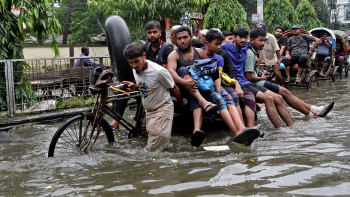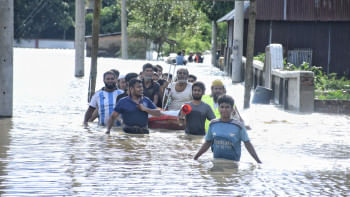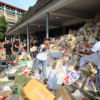Post-flood recovery will be challenging

As floodwaters slowly begin to recede, a grim reality is emerging across the 73 upazilas of 11 districts that have been affected over the last 10 days or so. The flood has left behind a vast trail of destruction—broken homes, crumbling roads, collapsed bridges, toppled electric poles, public facilities lying in ruins. The scars of the disaster are evident everywhere. Many have returned to their homes, or what's left of them, while others, whose villages are still under water, remain in the shelters. An uncertain future awaits them all. The thought of rebuilding their lives from the ground up can be daunting, yet this is what they must prepare for.
According to an estimate, at least 52 people have died in the flood. The human toll, tragic as it is, is just one component of the widespread devastation caused by it as survivors now must focus on the painful process of recovery, rehabilitation and reconstruction, with little help guaranteed. Many have lost their homes, livestock, and other belongings, and will need financial and institutional support to get back on their feet. A big part of the recovery also involves regaining livelihoods, especially for farmers, fishers, and other small earners. The government and private donors must ensure steady provision of not just food and clothes but also cash support, at least until some recovery is achieved. Another focus area is their health needs. Many in flood-affected areas are suffering from waterborne diseases including diarrhoea, skin infections, cold-fever, etc. So, ensuring adequate medical care is vital.
Unfortunately, this is proving to be difficult because of the flooding of many health facilities, including the 250-bed Feni General Hospital, that left them severely compromised. The ministry of disaster management and relief has reportedly deployed 619 medical teams across 11 districts. But ensuring the full resumption of local health complexes is crucial for uninterrupted care. There are many other areas of rebuilding and reconstruction that the government also needs to focus on urgently. While we are yet to know the full extent of the damage caused by the flood, initial estimates are quite alarming: 6,542 kilometres of roads damaged, and 1,066 bridges and culverts ruined. Highways in affected regions are in no better shape. Many utility structures have been destroyed. There has been widespread littering, with piles of garbage seen in many areas.
All these issues will require prompt and proper interventions. We are told that rescue and relief activities have been hampered because of coordination problems, despite an overwhelming response from people to support flood-hit communities. This has been exacerbated by the ongoing administrative chaos caused by transfers and other issues. The absence of upazila chairmen and other public representatives is also causing problems and will likely continue to do so for some more time. This is all the more reason why the government must double down on ongoing efforts, ensuring full cooperation of all relevant state agencies and officials, so that flood-affected communities have an easier go of it going forward. It must repair and resume all public facilities without delay, and must help the affected in every way it can.


 For all latest news, follow The Daily Star's Google News channel.
For all latest news, follow The Daily Star's Google News channel. 










Comments